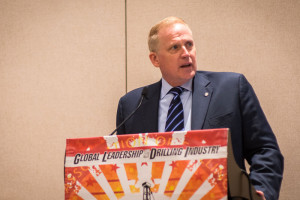BP’s Mingé: BOP reliability, safety management systems among areas requiring more industry collaboration
By Linda Hsieh, managing editor

Although the industry has changed significantly over the past few decades in terms of its technologies and operating environments, what we think of as a “good day” on a rig remains much the same. For BP, this includes controlling hydrocarbons with no injuries, understanding risks and maintaining barriers, and delivering quality projects on time, John Mingé, chairman and president of BP America, said last week. To achieve such “good days” and ensure today is always better than yesterday, he said, industry should focus on four areas for collaboration: BOP reliability, competency, safety management systems and teamwork. “We find that we get the best out of all our people – employees, contractors, suppliers – when we engage them actively, when we tap into their experiences and ask them to work side by side to deliver solutions,” Mr Mingé said during a keynote address at the 2013 IADC Annual General Meeting in San Antonio, Texas.
With BOPs, the reliability issue is especially important for subsea stacks, he said. “It’s a safety-critical device and needs enhanced collaboration. Operators don’t own their own subsea BOPs, and we depend heavily on the drilling contractor and the OEMs to provide long-term reliability.”
Earlier this year BP established a global subsea BOP reliability team to reduce safety and operational risks associated with BOPs and ultimately reduce the number of days associated with downtime. “We’ve been conducting between-well maintenance workshops to improve collaboration with drilling contractors on BOP reliability. The idea is to get the contractor, the OEM and the operator on a rig and basically design the maintenance plan on paper,” Mr Mingé said.
“As an industry we must work together more closely if we’re going to further enhance understanding of the issues around BOP reliability,” he continued.
A second area for collaboration is around building competency. BP has run nearly 200 courses this year at its Global Wells Institute in Houston, where the centerpiece is a state-of-the-art simulator for well control training. “Training and education has always been important, but its importance is increasing rapidly due to the turnover that’s happening in the industry,” he said.
Particularly as deepwater drilling expands, he continued, organizations like IADC are becoming more vital than ever. “We’ve been pleased in the last two years to support the IADC’s Knowledge, Skills and Abilities project, helping develop core competency requirements in key drilling positions. We look forward to continuing our engagements when IADC’s planned Well Control Institute starts up.”
Safety management systems is another area Mr Mingé sees for further collaboration. “We’re counting on our contractors to have strong safety management systems in place to manage the risk of operations, to make sure there are barriers in place, and to make sure that the people who are working on the rig know what they’re doing,” he said. For the past few months, BP has been working with its contractors to review their systems at multiple levels – executive, regional and global. “Together we are promoting commitment through our organizations and throughout the industry to barrier integrity and strength in procedural discipline.”
The final item on his list is teamwork, and Mr Mingé recounted an experience from the mid-’90s when deepwater drilling had yet to really take off. “Every single well we ran in about 100 days per 10,000 ft,” he recalled. To improve efficiency and hit their geologic targets while still preserving safety, his team kicked off a collaboration effort involving people who worked on the rigs. This included everyone from the toolpusher to the roustabouts to mud loggers and even boat captains and geoscientists. “The breakthrough in tackling challenges was not really just through the technical advancements but was by working together in a different way.”
By listening and engaging, the team was able to drill eight consecutive wells where the overall efficiency improved by 66%. “Every well was at least 50% better,” he said. “We really do want to be a preferred customer of our contractors and suppliers. We’re going to achieve that through working together and collaboration, and working hard and dealing with the challenges that we have for today and tomorrow.”




